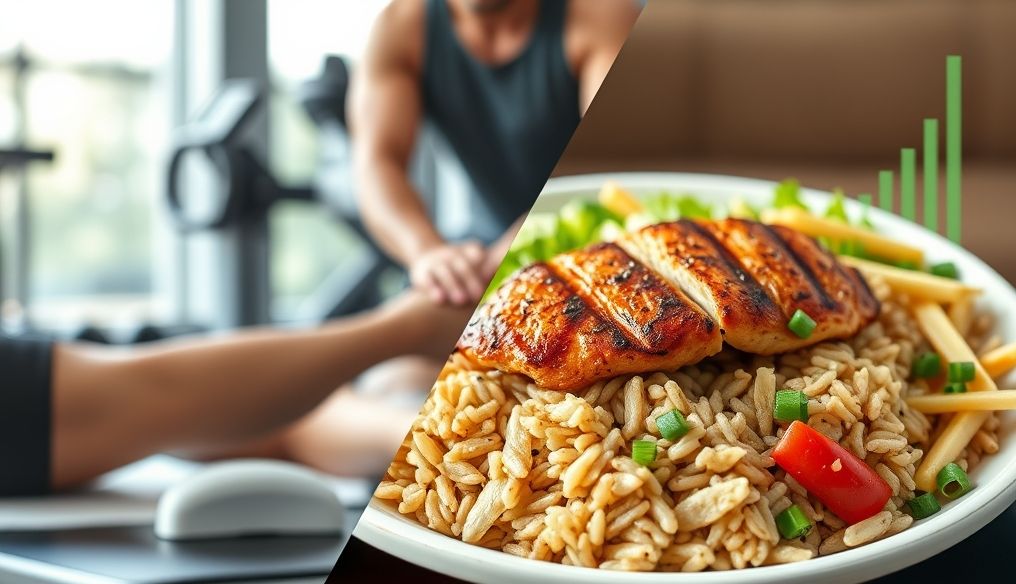Introduction: Why is Building Muscle Important?
Building muscle isn't just a cosmetic goal; it has numerous health benefits. It helps increase your basal metabolic rate, contributing to burning more calories even at rest. It also strengthens bones and joints, improves strength and endurance, and reduces the risk of chronic diseases like diabetes and heart disease.
Chapter 1: The Basics of Muscle Building: What You Need to Know
1.1. The Muscle Building Process (Hypertrophy)
Muscle hypertrophy is the process of increasing the size of muscle fibers. This process occurs as a result of resistance exercises that cause microscopic tears in the muscle fibers. The body then repairs and strengthens these fibers, leading to an increase in their size.
1.2. The Importance of Nutrition in Muscle Building
Nutrition is the cornerstone of muscle building. Without providing the necessary nutrients, the body will not be able to repair and grow muscle fibers. Protein is the most important nutrient, as it is the building block of muscles. Carbohydrates and fats are also essential for providing the energy needed for exercise and growth processes.
1.3. The Role of Rest and Recovery
Rest and recovery are just as important as exercise and nutrition. The body needs adequate time to recover from exercise and repair muscle fibers. Lack of sleep and stress can hinder the muscle-building process.
Chapter 2: Exercise: The Key to Building Muscle
2.1. Resistance Training: The Foundation
Resistance exercises are exercises that challenge your muscles against an external force, such as free weights, gym equipment, or body weight. These exercises are the most effective in stimulating muscle growth.
2.2. Types of Resistance Exercises
- Free Weights: Dumbbells, barbells, kettlebells.
- Gym Equipment: Chest press machines, pull-down machines, weightlifting machines.
- Bodyweight Exercises: Push-ups, pull-ups, squats, lunges.
2.3. Principles of Designing a Resistance Training Program
- Repetitions: The number of times you perform the exercise.
- Sets: The number of times you repeat the series of exercises.
- Rest: The time period between sets.
- Progressive Overload: Gradually increasing the difficulty of the exercises.
Chapter 3: Optimal Nutrition for Muscle Building
3.1. Protein: The Building Block
A person aiming to build muscle needs to consume an adequate amount of protein daily. Most studies recommend consuming 1.6-2.2 grams of protein per kilogram of body weight.
3.2. Good Sources of Protein
- Meat: Chicken, beef, fish.
- Dairy Products: Milk, yogurt, cheese.
- Eggs.
- Legumes: Lentils, beans, chickpeas.
- Nuts and Seeds.
3.3. Carbohydrates: The Energy Source
Carbohydrates provide the energy needed for exercise and growth processes. Choose complex carbohydrates such as whole grains, vegetables, and fruits.
3.4. Healthy Fats: Essential for Hormones
Healthy fats play an important role in the production of hormones, including testosterone, which is an essential hormone for muscle growth. Sources of healthy fats include avocados, nuts, olive oil, and fatty fish.
Chapter 4: Building Muscle at Home: Possible and Effective
4.1. Effective Bodyweight Exercises
Muscle can be built effectively at home using bodyweight exercises. Effective exercises include push-ups, pull-ups, squats, lunges, and planks.
4.2. Using Simple Tools to Increase Resistance
Simple tools such as resistance bands and light dumbbells can be used to increase resistance and stimulate muscle growth further.
4.3. Designing a Home Workout Program
A home workout program should include exercises that target all major muscle groups. Start with easy exercises and gradually increase the difficulty of the exercises.
Chapter 5: Building Muscle at the Gym: Endless Options
5.1. Taking Advantage of Gym Equipment
Gym equipment offers a wide range of exercises that target all muscle groups. Learn how to use the equipment correctly to avoid injuries.
5.2. Free Weights: A Real Challenge
Free weights such as dumbbells and barbells require more balance and coordination, making them more effective in building muscle and strength.
5.3. Tips for Training at the Gym
- Consult a sports coach: To get a personalized workout program and proper technique.
- Start with a light weight: And gradually increase the weight.
- Focus on the correct form: To avoid injuries.
- Listen to your body: And stop exercising if you feel any pain.
Chapter 6: Dietary Supplements: Are They Necessary?
6.1. Protein Powder: A Common Dietary Supplement
Protein powder is a common dietary supplement used to increase protein intake. It can be helpful for people who find it difficult to get enough protein from food.
6.2. Creatine: To Increase Strength and Performance
Creatine is a dietary supplement that helps increase strength and athletic performance. It is considered safe and effective for most people.
6.3. Other Dietary Supplements
There are many other dietary supplements that claim to help build muscle, but most are not supported by strong scientific evidence. Before taking any dietary supplement, consult your doctor or a nutritionist.
Chapter 7: Common Mistakes That Hinder Muscle Building
7.1. Not Eating Enough Protein
This is the most common mistake. Make sure you eat enough protein daily.
7.2. Not Getting Enough Sleep
Lack of sleep hinders the muscle-building process. Get 7-8 hours of sleep each night.
7.3. Overtraining
Overtraining can lead to injuries and fatigue. Give your body enough time to recover.
7.4. Not Progressing Gradually
If you don't gradually increase the difficulty of the exercises, your muscles will not continue to grow.
Chapter 8: Additional Tips for Achieving the Best Results
- Be patient and persistent: Building muscle takes time and effort.
- Track your progress: Record your workouts and measurements to monitor your progress.
- Enjoy the process: Make building muscle a fun part of your life.
- Stay hydrated: Drink plenty of water.
- Avoid smoking and alcohol: They hinder the muscle-building process.
Conclusion: Building muscle requires a commitment to exercise, nutrition, and rest. Follow the tips in this article to achieve your muscle-building goals.




